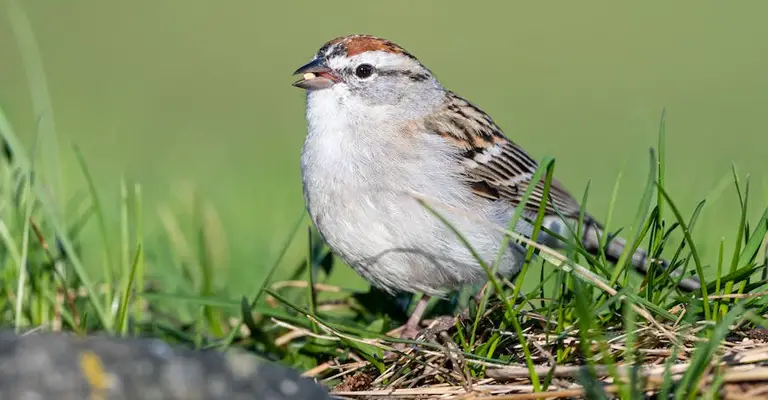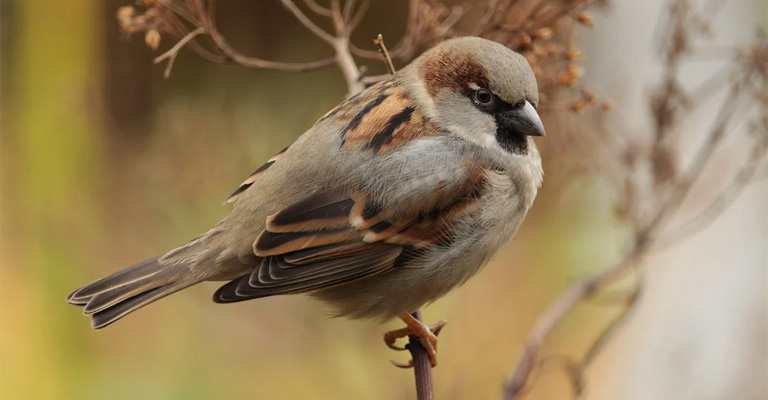Identifying birds adds a layer of fascination to our outdoor experiences, and the house sparrow (Passer domesticus) provides an excellent starting point. A ubiquitous companion in urban and suburban landscapes, the house sparrow’s distinct features and behaviors make it a relatively easy species to recognize.
With its petite size, captivating coloration, and lively presence, distinguishing the house sparrow from other avian inhabitants becomes an engaging venture.
In this exploration, we delve into how do you identify a house sparrow, shedding light on its appearance, vocalizations, habitat preferences, and more.
Whether you’re an enthusiastic birdwatcher or simply intrigued by the avian world around you, these insights into identifying the house sparrow will enhance your connection to the natural tapestry of your surroundings.

How Do You Identify A House Sparrow?
Identifying a house sparrow (Passer domesticus) can be quite straightforward once you become familiar with its distinct characteristics.
Here are some tips to help you recognize this common bird:
Size and Shape
House sparrows are small birds, about 5.5 to 6.5 inches in length, with stout bodies and short tails. Their chunky appearance and rounded head are key features to notice.
Coloration
Adult male house sparrows have a distinctive appearance. Their crown is chestnut-brown, and they have a black throat patch, creating a stark contrast against their grayish body.
The rest of their body is streaked in shades of brown and gray. Females and juveniles lack the bold markings and are more subdued in color.
Facial Markings
Males possess a prominent black bib or throat patch that extends down the sides of their neck. This black patch is a defining characteristic, making it easily recognizable.
Bill
Their conical bill is short and sturdy, adapted for cracking seeds and grains, which constitute a significant portion of their diet.
Voice
House sparrows are known for their lively and often noisy chatter. They produce a variety of chirps, cheeps, and chattering sounds. Their vocalizations are easily distinguishable once you’ve heard them a few times.
Urban Dwellers
House sparrows are highly adaptable birds and are commonly found in urban and suburban areas. They often inhabit human-made structures such as buildings, bridges, and signs.
Group Behavior
These birds are social creatures and are often seen in groups. Observing their interactions and group dynamics can help confirm their identity.
Nesting Habits
House sparrows build their nests in a variety of locations, including building crevices, vents, and trees.
Their nests are untidy and made from a mix of twigs, grass, feathers, and other materials.
Behavior
Watch their behavior around feeding areas. House sparrows are opportunistic feeders and can be seen scavenging for food around bird feeders, outdoor dining areas, and crumbs near human activity.
Identifying a house sparrow involves noting its size, coloration, facial markings, bill shape, vocalizations, habitat preferences, nesting behavior, social tendencies, and feeding habits.
By combining these key characteristics, you can confidently identify these common and often charming urban birds.
What Are Some Sparrow Identification Equipment?
Some sparrow identification equipment that can help you recognize different species of sparrows are:
Binoculars:

Binoculars are essential for identifying sparrows in order to clearly see markings on these small birds. Choose a pair of binoculars with a wide field of view so you can easily follow moving birds.
The lens should be wide enough to admit sufficient light for watching small birds in shaded shrubbery and other dim habitats. A larger magnification can help make even small markings easier to see.
Field Guide:

A good field guide is invaluable, no matter what types of birds you hope to identify.
Choose a guide that shows different variations of sparrows’ plumage, or that includes tips on challenging sparrow species in order to identify these birds easily.
Some examples of field guides that you can use to identify sparrows are:
The Sibley Guide to Birds
A comprehensive and authoritative guide that covers all the birds of North America, with detailed illustrations, maps, and descriptions.
Peterson Field Guide to Birds of North America
A classic and popular guide that uses a simple and effective identification system based on shape, color, and pattern.
National Geographic Field Guide to the Birds of North America
A user-friendly and updated guide that features stunning photographs, range maps, and identification tips.
Neutral Clothing

Sparrows can be quite shy and easily spooked. To give yourself an opportunity to get closer to the birds for the best views, choose loose, comfortable clothing in neutral, natural colors.
Avoid clothes that rustle or jangle excessively, as the birds will easily hear these noises long before you spot them.
Smartphone Or Tablet
A smartphone or tablet can be a useful device for identifying sparrows, as you can download apps that can help you identify birds by using photos, sounds, maps, or quizzes.
Some examples of apps that you can use to identify sparrows are:
Merlin Bird ID
A free app by the Cornell Lab of Ornithology that helps you identify birds by answering five simple questions or by using a photo.
Audubon Bird Guide
A free app by the National Audubon Society that helps you identify over 800 bird species in North America by using photos, sounds, maps, or filters.
eBird
A website and app by the Cornell Lab of Ornithology that allows you to record and share your bird sightings, explore bird data, and learn more about birds.
Notebook And Pen

A notebook and pen are handy tools for identifying sparrows, as you can jot down notes on the birds’ appearance, behavior, sounds, location, and date.
This can help you remember the details later or compare them with your field guide or app. You can also sketch the birds or their markings to help you visualize them better.
Camera

A camera is another useful tool for identifying sparrows, as you can take photos of the birds and zoom in on them later to see their features more clearly.
You can also share your photos with other birders or experts who can help you confirm your identification or correct your mistakes.
Audio Recorder
An audio recorder is a helpful tool for identifying sparrows by their songs and calls, which are often distinctive and diagnostic.
You can record the sounds of the birds and play them back later to compare them with your field guide or app. You can also use an audio recorder to learn the songs and calls of different sparrow species by listening to them repeatedly.
How To Identify Sparrows By Markings?

Sparrows are small, brown birds that can be hard to identify by their markings, but with some practice and attention to detail, you can learn how to tell them apart.
Here are seven types of markings that can help you identify sparrows:
Head Markings
The head of a sparrow can have various patterns of stripes, spots, or colors that can help you distinguish different species.
For example, the white-crowned sparrow has a bold black-and-white striped crown, the song sparrow has a dark spot on its chestnut cheek, and the chipping sparrow has a bright rufous cap.
Eye Markings
The eye of a sparrow can have different features that can help you identify it, such as an eye ring, an eye stripe, or a supercilium (eyebrow).
For example, the golden-crowned sparrow has a yellow supercilium and a black eye stripe, the lark sparrow has a white eye ring and a chestnut spot behind the eye, and the savannah sparrow has a yellow spot in front of the eye.
Bill Shape And Color
The bill of a sparrow can vary in shape and color depending on the species and the season. Some sparrows have thick, conical bills for cracking seeds, while others have thinner, pointed bills for picking insects.
For example, the house sparrow has a black bill in summer and a yellowish-grey bill in winter, the American tree sparrow has a bicolored bill with a dark upper mandible and a yellow lower mandible, and the fox sparrow has an all-dark bill.
Wing Markings
The wing of a sparrow can have different markings that can help you identify it, such as a wing bar, a wing patch, or a wing stripe.
For example, the house sparrow has a white wing bar, the swamp sparrow has a reddish-brown wing patch, and the Lincoln’s sparrow has a buffy wing stripe.
Tail Markings
The tail of a sparrow can have different markings that can help you identify it, such as tail spots, tail feathers, or tail shape. Tail spots are white patches on the outer tail feathers that are visible when the bird flies or spreads its tail.
Tail feathers are the individual feathers that make up the tail and can vary in color or pattern. Tail shape is the overall form of the tail and can be long or short, square or notched, rounded or pointed.
For example, the white-throated sparrow has white tail spots, the dark-eyed junco has white outer tail feathers, and the vesper sparrow has a short and notched tail.
Underpart Markings
The underparts of a sparrow can have different markings that can help you identify it, such as streaks, spots, or washes.
Streaks are lines of darker color on the breast, flanks, or belly that can vary in width or intensity. Spots are dots or patches of darker color on the chest or throat that can vary in size or shape.
Washes are tints or shades of color on the underparts that can vary in hue or saturation.
For example, the white-crowned sparrow has streaked flanks, the song sparrow has spotted breasts, and the chipping sparrow has a pinkish wash on its underparts.
Overall Coloration
The overall coloration of a sparrow can help you identify it by comparing it with other similar species or by noting any distinctive hues or contrasts.
Sparrows can range from plain brown to bright yellow or red in their plumage, depending on their species and subspecies. Some sparrows have more uniform colors throughout their body, while others have more contrast between their upperparts and underparts.
For example, the house finch is mostly red on its head and breast, the clay-colored sparrow is mostly pale brown on its upperparts and underparts, and the field sparrow is mostly rufous on its upperparts and white on its underparts.
FAQ
House sparrows are small birds, measuring around 5.5 to 6.5 inches in length. Their stout body, short tails, and rounded heads contribute to their distinctive appearance.
Male house sparrows feature a chestnut-brown crown, a black throat patch, and a grayish body streaked with brown. The prominent black bib on their throat is a key identifier.
No, females lack the bold markings of males. They sport more subdued coloration, with a generally grayish-brown appearance and less distinct facial features.
House sparrows are adaptable urban dwellers. They thrive in human-made environments like cities, suburbs, and farmlands, often nesting in buildings, bridges, and other structures.
House sparrows are known for their chatty nature. They produce a variety of chirps, cheeps, and chattering sounds. Their vocalizations are distinct once you become familiar with their lively and noisy chatter.
Conclusion
In a world where urban and rural landscapes intertwine, the house sparrow stands as a resilient emblem of adaptability.
Its ability to thrive alongside human activity while maintaining its unique traits serves as a testament to the diverse interactions between species.
By discerning its features—ranging from the distinguished black throat patch of the male to its sociable behaviors and chirping conversations—one can uncover the story of the house sparrow’s life amidst our bustling environments.
As we take a moment to peer into the avian realm and decipher the clues that mark the house sparrow’s presence, we not only enrich our own understanding but also foster a deeper appreciation for the often-overlooked beauty that resides just outside our windows.